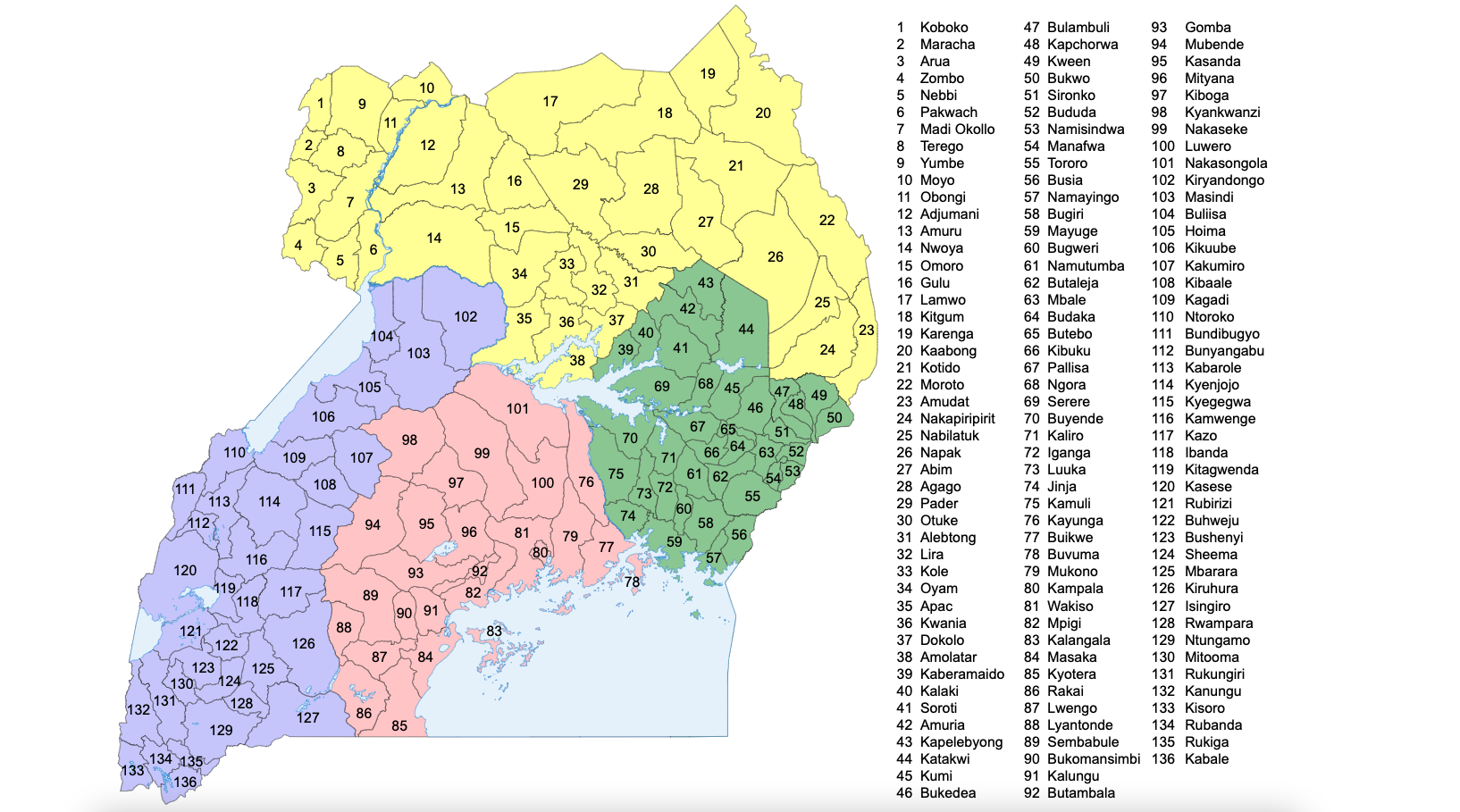|
Acholibur
Acholibur is a town in Pader District in the Northern Region of Uganda. Location Acholibur is approximately , by road, south of Kitgum, the nearest large urban centre. The coordinates of Acholibur are 03°08'37.0"N, 32°54'49.0"E (Latitude:3.143611; Longitude:32.913611). Points of interest These are some of the points of interest in or near Acholibur: * offices of the Acholibur Town Council * headquarters of the Acholibur sub-county * northern end of the Acholibur–Gulu–Olwiyo Road * Rwekunye–Apac–Aduku–Lira–Kitgum–Musingo Road, passing through town in a generally north/south direction See also * List of cities and towns in Uganda * List of roads in Uganda The following is a list of the national roads in Uganda, which are under the jurisdiction of the Uganda National Roads Authority. The list is not exhaustive. National roads See also * Economy of Uganda * Transport in Uganda *Kinshasa Highway ... References External links * {{Pader District Pader D ... [...More Info...] [...Related Items...] OR: [Wikipedia] [Google] [Baidu] |
Acholibur–Gulu–Olwiyo Road
The Acholibur–Gulu–Olwiyo Road is a road in the Northern Region of Uganda, connecting the town of Acholibur to the city of Gulu and the town of Olwiyo. Location The road starts at Acholibur, a small town on the Kitgum–Lira road, approximately south of Kitgum. The road continues in a southwesterly direction to Gulu (2014 population: 152,276), the most populous city in the Northern Region. The road then continues through Nwoya and Anaka to end at Olwiyo in Nwoya District, a distance of about . The road connects the districts of Kitgum, Pader, Gulu, and Nwoya. The coordinates of the road near Gulu are 2°48'24.0"N, 32°19'29.0"E (Latitude:2.806667; Longitude:32.324722). Upgrading to bitumen In 2009, the Ugandan government commissioned a feasibility study and detailed engineering design for both this road and the Rwekunye–Apac–Aduku–Lira–Kitgum–Musingo Road, each in northern Uganda. The reports became available in 2013. On 21 February 2015, the upgrade from unsea ... [...More Info...] [...Related Items...] OR: [Wikipedia] [Google] [Baidu] |
Rwekunye–Apac–Aduku–Lira–Kitgum–Musingo Road
Rwekunye–Apac–Aduku–Lira–Kitgum–Musingo Road is a road in the Northern Region of Uganda, connecting the towns of Masindi Port in Kiryandongo District to Apac in Apac District, Lira in Lira District, Acholibur in Pader District, Kitgum in Kitgum District, and Musingo in Lamwo District at the international border with South Sudan. Location The road starts at Rwekunye, a suburb of the town of Masindi Port, on the Kampala-Gulu highway, about west of the Victoria Nile. The road continues through five northern Ugandan districts to end at Musingo, a total distance of about . The coordinates of the road near Lira are 2°22'27.0"N, 32°56'04.0"E (Latitude:2.374167; Longitude:32.934444). Upgrading to bitumen In 2009, the Ugandan government commissioned a feasibility study and a detailed engineering design for this road and for the Acholibur–Gulu–Olwiyo Road, both in northern Uganda. The reports became available in 2013. In February 2015, the upgrade from unsealed gravel s ... [...More Info...] [...Related Items...] OR: [Wikipedia] [Google] [Baidu] |
List Of Roads In Uganda
The following is a list of the national roads in Uganda, which are under the jurisdiction of the Uganda National Roads Authority. The list is not exhaustive. National roads See also * Economy of Uganda * Transport in Uganda *Kinshasa Highway References {{reflist, 2 External linksUNRA, World Bank in talks to resume road funding Roads in Uganda Uganda
}), is a landlocked country in East Africa. The country is bordered to the east by Kenya, to the north by South Sudan, to the west by the Democratic Republic of the Congo, to the south-west by Rwanda, and t ...
[...More Info...] [...Related Items...] OR: [Wikipedia] [Google] [Baidu] |
Kitgum
Kitgum is a municipality in Kitgum District in the Northern Region of Uganda. The town is administered by Kitgum Municipality Council, an urban local government. It is the largest metropolitan area in the district and the site of the district headquarters. Location Kitgum is bordered by Lamwo District to the north, ''Mucwini'' to the north-east, Kitgum Matidi to the east, Acholibur to the south, and Pajimu to the west. The town is located approximately , by road, north-east of Gulu, the largest city in the Acholi sub-region. This is approximately , by road, north of Uganda's capital Kampala. The geographical coordinates of Kitgum are 3°17'20.0"N, 32°52'40.0"E (Latitude:3.288889; Longitude:32.877778). Population On 27 August 2014, the national population census put the population of Kitgum town at 44,604. Points of interest The following additional points of interest are located within or near the town of Kitgum: Acaki Lodge mid range lodge with 10 chalets built of local ma ... [...More Info...] [...Related Items...] OR: [Wikipedia] [Google] [Baidu] |
Flag Of Uganda
The flag of Uganda ( Ugandan Languages: ''Bendera ya Uganda'') was adopted on 9 October 1962, the date that Uganda became independent from the British Empire. It consists of six equal horizontal bands of black (top), yellow, red, black, yellow, and red (bottom); a white disc is superimposed at the centre and depicts the national symbol, a grey crowned crane, facing the hoist's side. During the colonial era the British used a British Blue ensign defaced with the colonial badge, as prescribed in 1865 regulations. Buganda, the largest of the traditional kingdoms in the colony of Uganda, had its own flag. However, in order to avoid appearing to give preference to one region of the colony over any other, the British colonial authorities selected the crane emblem for use on the Blue ensign and other official banners. History When the Democratic Party ruled the country, a design for flag was proposed. It had vertical stripes of green-blue-green, separated by narrower yellow stripes, a ... [...More Info...] [...Related Items...] OR: [Wikipedia] [Google] [Baidu] |
Uganda
}), is a landlocked country in East Africa. The country is bordered to the east by Kenya, to the north by South Sudan, to the west by the Democratic Republic of the Congo, to the south-west by Rwanda, and to the south by Tanzania. The southern part of the country includes a substantial portion of Lake Victoria, shared with Kenya and Tanzania. Uganda is in the African Great Lakes region. Uganda also lies within the Nile basin and has a varied but generally a modified equatorial climate. It has a population of around 49 million, of which 8.5 million live in the capital and largest city of Kampala. Uganda is named after the Buganda kingdom, which encompasses a large portion of the south of the country, including the capital Kampala and whose language Luganda is widely spoken throughout the country. From 1894, the area was ruled as a protectorate by the United Kingdom, which established administrative law across the territory. Uganda gained independence from the UK on 9 Oc ... [...More Info...] [...Related Items...] OR: [Wikipedia] [Google] [Baidu] |
Regions Of Uganda
The regions of Uganda are known as Central, Western, Eastern, and Northern. These four regions are in turn divided into districts. There were 56 districts in 2002, which expanded into 111 districts plus one city (Kampala) by 2010. The national government interacts directly with the districts, so regions do not have any definite role in administration. Under British rule before 1962, the regions were functional administrative units and were called provinces, headed by a Provincial Commissioner. The central region is the kingdom of Buganda, which then had a semi-autonomous government headed by the Kabaka (king). The equivalent of the Provincial Commissioner for Buganda was called the Resident.Uganda Protectorate annual report, Government Printer, Entebbe, 1959 At Uganda's 2002 census, the Central region (It is coterminous with the Kingdom of Buganda, one of the ancient African monarchies that are constitutionally recognised in Uganda) contained 27 percent of the country's popu ... [...More Info...] [...Related Items...] OR: [Wikipedia] [Google] [Baidu] |
Northern Region, Uganda
The Northern Region is one of four regions in the country of Uganda. As of Uganda's 2014 census, the region's population was . Districts As of 2010, the Northern Region had 30 districts A district is a type of administrative division that, in some countries, is managed by the local government. Across the world, areas known as "districts" vary greatly in size, spanning regions or county, counties, several municipality, municipa ...: References External links Google Map of the Northern Region of Uganda {{Districts of Uganda Regions of Uganda ... [...More Info...] [...Related Items...] OR: [Wikipedia] [Google] [Baidu] |
Districts Of Uganda
As of 17 November 2020, Uganda is divided into 136 districts and the capital city of Kampala, which are grouped into four administrative regions. Since 2005, the Ugandan government has been in the process of dividing districts into smaller units. This decentralization is intended to prevent resources from being distributed primarily to chief towns and leaving the remainder of each district neglected. Each district is further divided into counties and municipalities, and each county is further divided into sub-counties. The head elected official in a district is the chairperson of the Local Council five (usually written with a Roman numeral V). Below are population figures from the 2014 census (tables show population figures for districts that existed in 2014). __NOTOC__ Districts created since 2015 In September 2015, the Parliament of Uganda created 23 new districts, to be phased in over the next four years. In May 2020, Parliament approved the creation of Terego Dis ... [...More Info...] [...Related Items...] OR: [Wikipedia] [Google] [Baidu] |
Pader District
{{disambig, geo, surname ...
Pader may refer to: People with the surname *Hilaire Pader (1607-1677), French painter and poet. Places * Pader District, a district of Uganda * Pader, Uganda, capital of Pader District * Pader (river), a river in Germany Organizations * PADER, the Party for Democracy and Reconciliation * PaDER, Pennsylvania Department of Environmental Protection The Pennsylvania Department of Environmental Protection (DEP) is the agency in the U.S. state of Pennsylvania responsible for protecting and preserving the land, air, water, and public health through enforcement of the state's environmental laws. ... [...More Info...] [...Related Items...] OR: [Wikipedia] [Google] [Baidu] |
Towns In Uganda
This is a list of cities and towns in Uganda: The population data are for 2014, except where otherwise indicated. The references from which the estimated populations are sourced are listed in each article for the cities and towns where the population estimates are given. Twenty largest cities by population The following population numbers are from the August 2014 national census, as documented in the final report of November 2016, by the Uganda Bureau of Statistics (UBOS). Cities In May 2019, the Cabinet of Uganda approved the creation of 15 cities, in a phased manner, over the course of the next one to three years, as illustrated in the table below. The 7 of the 15 cities started operations on 1 July 2020 as approved by the Parliament of Uganda. Cities and towns References External links Uganda: Regions, Major Cities & Towns - Population as per 2014 Census {{Africa topic, List of cities in Uganda, List of cities in Uganda Cities A city is a human se ... [...More Info...] [...Related Items...] OR: [Wikipedia] [Google] [Baidu] |
County
A county is a geographic region of a country used for administrative or other purposes Chambers Dictionary, L. Brookes (ed.), 2005, Chambers Harrap Publishers Ltd, Edinburgh in certain modern nations. The term is derived from the Old French denoting a jurisdiction under the sovereignty of a count ( earl) or a viscount.The Oxford Dictionary of English Etymology, C. W. Onions (Ed.), 1966, Oxford University Press Literal equivalents in other languages, derived from the equivalent of "count", are now seldom used officially, including , , , , , , , and ''zhupa'' in Slavic languages; terms equivalent to commune/community are now often instead used. When the Normans conquered England, they brought the term with them. The Saxons had already established the districts that became the historic counties of England, calling them shires;Vision of Britai– Type details for ancient county. Retrieved 31 March 2012 many county names derive from the name of the county town ( county se ... [...More Info...] [...Related Items...] OR: [Wikipedia] [Google] [Baidu] |





